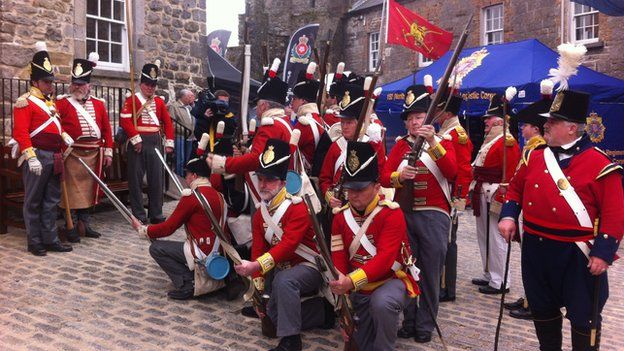Battle of Waterloo: Enniskillen commemorates role of Irish soldiers
- Published

A re-enactment of the battle was held at Enniskillen Castle
The role played by Irish soldiers in the Battle of Waterloo 200 years ago has been commemorated in Enniskillen.
The Inniskilling Dragoons and Fusiliers both fought in the battle and helped to turn the tide of European history as the Duke of Wellington beat Napoleon.
The heavy losses they suffered has been recalled at a memorial service at St Macartin's Cathedral, Enniskillen, County Fermanagh.
There has also been a battle re-enactment at Enniskillen Castle.
Legacy
Neil Armstrong is curator of the Inniskilling Regimental Museum.
"We want people to realise, first of all, the significance of the battle, the role that these Inniskilling men played, the significant role," he said.
"We want to commemorate, we want to educate and we want to leave a lasting legacy within our museum collection."
Pte Peter McMullen's Waterloo medal has been acquired by the Inniskillings Regimental Museum
The museum has acquired two new Waterloo medals to add to its collection, including the medal of Private Peter McMullan, whose story of survival has been written into the folklore of the battle, external.
Another medal belonged to Enniskillen man Troop Sgt Major Isaac Emerson, from the Inniskilling Dragoons.
Mr Armstrong said he had also survived the battle.
"He actually had 24 years' service and was discharged, and on his report it said "having been worn out", which is understandable considering what he had went through."
Awarded
He said their experience on the muddy battlefield at Waterloo "would have been horrific".
Also on public display for the first time are items belonging to Lord Brookeborough's family, who had two relatives on the battlefield.
Lord Brookeborough displays the medals of his relative Lt Francis Brooke who survived Waterloo
Col Francis Brooke of the 4th Regiment fought in most of the Peninsula War, and was awarded the silver Waterloo medal as well as the Waterloo gold cross and Peninsula gold medal.
His 22-year-old nephew, also called Francis, was a Lt serving with the 1st Inniskilling Dragoon Guards.
He was killed in battle.
It is thought his body is buried in a mass grave by the side of a farm at La Haye Sainte in present-day Belgium.
A memorial at Aghalurcher Parish Church in Colebrooke, County Fermanagh, records that he was killed "when gallantly charging the French in the ever memorable Battle of Waterloo".
Lt Brooke's contribution at the battle is recorded in a memorial at Aghalurcher Parish Church
Lord Brookeborough said the bicentenary is an important landmark to remember the sacrifice of those who died.
"I think we don't realise the carnage that did occur [at Waterloo], but we are now more aware of it because of so many books lately that have come out," he said.
"It did amount to freedom because France, or Napoleon in particular, was really trying to take over the whole of Europe."
- Published30 May 2015